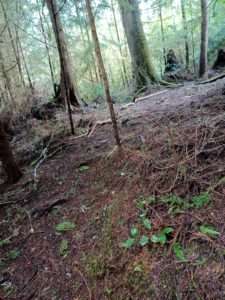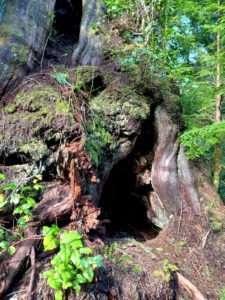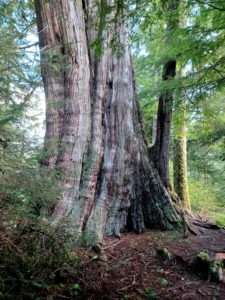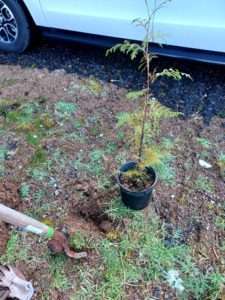Last Wednesday I had the opportunity to do some volunteering with Willapa National Wildlife Refuge. As the weather has finally turned better, with some warm, sunny days mixed in with the rain, it’s made conditions more favorable to getting outside. So when I got the email asking if I wanted to help plant some cedar trees, I jumped at the chance.
 Western red cedar (Thuja plicata) is my very favorite tree. It’s not a true cedar, instead being a member of the cypress family Cupressaceae. But there’s something about the red-tinted bark powdered with Cladonia lichens, and the flat, scaly green needles that appeals to me. Maybe it’s because it’s some of the best of the coloration of Pacific Northwest forests all wrapped in one tree. Or perhaps it’s because I loved eastern red cedar (Juniperus virginiana) so much as a child, and I’ve just developed a fondness for cedars that aren’t actually cedars.
Western red cedar (Thuja plicata) is my very favorite tree. It’s not a true cedar, instead being a member of the cypress family Cupressaceae. But there’s something about the red-tinted bark powdered with Cladonia lichens, and the flat, scaly green needles that appeals to me. Maybe it’s because it’s some of the best of the coloration of Pacific Northwest forests all wrapped in one tree. Or perhaps it’s because I loved eastern red cedar (Juniperus virginiana) so much as a child, and I’ve just developed a fondness for cedars that aren’t actually cedars.
We have only a few tiny patches of old-growth forest here in the extreme southwest corner of Washington, mostly populated with ancient cedars and a few very old Sitka spruce (Picea sitchensis). My first real look at old-growth forest here was Teal Slough, a section of Willapa NWR that protects 140 acres. These ancient trees very nearly ended up logged a few decades ago, but for the heroic efforts of historian Rex Ziak. In the pre-internet times he spent months tracking down the then-corporate owners of this tract of land, and managed to convince them to cease logging with a letter, a photograph, and a rope loop the same circumference as one of these massive old cedars. (It’s a pretty incredible story that I got to hear him tell in person at Wings Over Willapa a few years ago.)
It really was at the eleventh hour, though. One of the first things an astute naturalist will notice when arriving at Teal Slough is that almost all of the trees are either very old–or very young. That’s because the undergrowth had been bulldozed in preparation for chopping down the couple dozen big trees left. It’s rebounded in recent years, but there are tons of scrawny young western hemlock trees (Tsuga heterophylla) along with a scattering of young cedars.
Adding more cedars was our original goal for that morning, which was cool but sunny. We brought ten young trees with us, but stopped at the old Refuge headquarters just down the road from Teal Slough. It turned out that the place we were originally going to plant them was where the old logging road cut through, and the heavy gravel made digging by hand impossible. So we planted eight to create a windbreak at the old HQ, which is itself going through a slow metamorphosis, and tucked the other two back into the truck.
 And then it was time to head to Teal Slough itself. While we couldn’t plant trees, we could still pick up debris from the storms that came through. The bigger branches and fallen saplings made good material for outlining the trails, making them more visible to visitors. While the old logging road is pretty obvious, some of the footpaths that diverge off the main trail to showcase big trees further back in the woods were getting tougher to discern. So we spent some time lining them with some of the windfallen materials.
And then it was time to head to Teal Slough itself. While we couldn’t plant trees, we could still pick up debris from the storms that came through. The bigger branches and fallen saplings made good material for outlining the trails, making them more visible to visitors. While the old logging road is pretty obvious, some of the footpaths that diverge off the main trail to showcase big trees further back in the woods were getting tougher to discern. So we spent some time lining them with some of the windfallen materials.
But I also want to touch on the original reason we were slated to go out there that day. See, those young cedars were originally going to be used to help start to close off the last hundred feet or so of the trail. This last bit leads down to one of the biggest of the cedars at Teal Slough, and–to be quite honest–my favorite.
 As it turns out, she’s not doing so well. She’s been rotted out inside for some time; this is normal, of course; in many cases an old tree can survive its heartwood rotting away completely, since that wood is dead. But this old cedar has been beginning to lean noticeably toward the northwest in recent months. There’s no disruption at ground level yet, no cracks in the earth or roots bursting forth to the surface. A Refuge employee was on the trail a few months ago during one of the vicious windstorms we’ve had over the winter, and he noticed this tree swaying more than usual.
As it turns out, she’s not doing so well. She’s been rotted out inside for some time; this is normal, of course; in many cases an old tree can survive its heartwood rotting away completely, since that wood is dead. But this old cedar has been beginning to lean noticeably toward the northwest in recent months. There’s no disruption at ground level yet, no cracks in the earth or roots bursting forth to the surface. A Refuge employee was on the trail a few months ago during one of the vicious windstorms we’ve had over the winter, and he noticed this tree swaying more than usual.
We don’t know when she’ll fall. It might be later this year; it might not be for another century. But it was decided that the trail to her should be closed off just in case she came down when there were people around. A massive tree of this size would be quite a danger indeed; the day after our volunteering a logger was killed in the Willapa Hills after being hit by a much smaller tree. Even a section of this tree coming down at the wrong time could be disastrous. And beyond a certain size there’s really no way to buttress such an enormous thing, especially when it’s located on a slope of super-saturated soil.
 We walked down the trail to where she still stood with her much younger hemlock “buddy tree” growing out of her side; many of the old cedars have similar hemlock companions. It was apparent she was listing more than I had seen her in the past, and there seemed to be a little more space between her and her hemlock. We all spoke of how magnificent she was, and how sad that it seemed she was nearing her end.
We walked down the trail to where she still stood with her much younger hemlock “buddy tree” growing out of her side; many of the old cedars have similar hemlock companions. It was apparent she was listing more than I had seen her in the past, and there seemed to be a little more space between her and her hemlock. We all spoke of how magnificent she was, and how sad that it seemed she was nearing her end.
I lingered behind for a moment while everyone else moved the “End of Trail” sign back up to where the path would be cut off. It was my last moment to be up close and personal to this beautiful old cedar. While technically, yes, I could still steal up the path before it was completely planted or fenced or however the Refuge will eventually close it, I respect their decision and decided this would be my farewell. I told the tree how much I had enjoyed visiting her, and thanked her young hemlock as well. I touched the lichens that adorned her furrowed bark, and looked up at the broken crown of branches at her top.
Then I turned, with many glances backwards at a Eurydice I would never be able to bring home. I dragged with me a young alder that had fallen in a storm, and added it to the small pile of branches placed across the trail as a temporary barrier. And we headed back down to the road, with the sound of a pileated woodpecker (Dryocopus pileatus) rapping high overhead, and a rough-skinned newt (Taricha granulosa) waiting for us at the trailhead.
I don’t know when the old cedar will finally fall over, but when she does her death will not be in vain. Like all fallen trees, the countless molecules she accumulated over a millennium of life will slowly start to disperse throughout the forest through the actions of detritivores and decomposers. She will feed bacteria and fungi, insects that then become food for birds, and a whole host of plants that will make use of the vast stores of nutrients she holds, and the sunlight that her passing will reveal to the forest floor. Nothing ever goes to waste in a forest, not least of all a fallen tree.
 As we drove back down 101 toward the new headquarters, I gave a glance to where we had planted the young cedars. I would never live to see them achieve that great stature; in fact, not all of them may even make it to maturity, especially if cedar die-back continues in our too-hot summers. But it is hope that allows me to continue to plant new things amid loss. I cannot help but try, even against the odds. And I can do two things at once: I can mourn the eldest of the trees as she makes her literal last stand, and I can also loosen the soil for one of her relatives to set roots and grow.
As we drove back down 101 toward the new headquarters, I gave a glance to where we had planted the young cedars. I would never live to see them achieve that great stature; in fact, not all of them may even make it to maturity, especially if cedar die-back continues in our too-hot summers. But it is hope that allows me to continue to plant new things amid loss. I cannot help but try, even against the odds. And I can do two things at once: I can mourn the eldest of the trees as she makes her literal last stand, and I can also loosen the soil for one of her relatives to set roots and grow.
